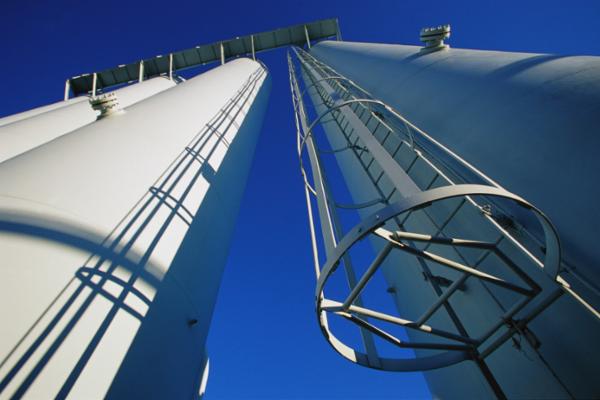Measuring and controlling
Measurement technology is concerned with determining physical quantities such as length, mass, force, pressure, electrical current, temperature or time using various devices. This makes it the first step towards automation and is indispensable today as it not only monitors the quality of the product in the form of measurement and test data in the product development process, but also ensures the safety of the production process.
The physical variables are measured by the sensors, which are available in different versions depending on the measuring method. The sensor, also called a "sensor", measures an actual value and forwards it to a data processor to be compared with a predefined target value. From our everyday life, such sensors are known to us and they provide our comfort and safety such as automatic doors, smoke detectors and all the technology in our cars. Below is an overview of how sensors are used in chemical plant engineering.
Temperature
Electrical temperature measurementThe basis of all electronic temperature measuring instruments is a sensor that converts the measured temperature into an electrical signal.
- Thermocouples - consist of two welded wires of different materials. The welding point represents the actual measuring point.
- Resistance thermometer - With a resistance thermometer the measuring resistance changes depending on the temperature.
- Temperature Switches - Temperature switches transmit control and analogue output signals to the processes in addition to measuring the temperature.
- Temperature transmitters - Temperature transmitters are mounted on a DIN rail in the control cabinet or in the connection head directly at the measuring point.
Mechanical temperature measurementThese are so-called expansion thermometers, since the measuring principle is based on the expansion of temperature-dependent materials.
- Bimetallic thermometers - consist of two connected metal strips with different expansion behavior. The resulting curvature is the measure of the temperature.
- Gas pressure thermometers - are filled with an inert gas or gas mixture. The temperature-dependent gas pressure change leads via a capillary line to indicate the temperature.
- Tension thermometers - include a liquid-filled measuring system, which also leads to a pressure change when the temperature changes, which is indicated by an integrated pointer movement.
Infrared Temperature Measurement
The basic technology is based on semiconductor products and offers a range of non-contact temperature sensors.
- Infrared Thermometer
- Thermal imaging cameras
Pressure
In addition to temperature, pressure is one of the most important physical state variables. Depending on which pressure is used as a reference for the measurement, different types of pressure are distinguished:
absolute pressure
The reference quantity for this type of print is the zero pressure prevailing in the vacuum of the universe. For the necessary differentiation from other types of printing, it is marked with the index abs.
Atmospheric pressure
It is caused by the weight of the air surrounding the earth up to a height of approx. 500 km. Up to this altitude, where absolute pressure = zero, its size is constantly decreasing. At sea level it is on average
1013.25 mbar.
differential pressure
The difference between two pressures is called pressure difference. To measure differential pressure, two different pressures are initially recorded in a measuring device. Only if the measured values are different, a differential pressure is displayed. Measuring differential pressure is used, for example, in level measurement and in monitoring systems.
Overpressure (relative pressure)
The most commonly measured pressure in the art is the atmospheric pressure differential. It is the difference between an absolute pressure and the respective atmospheric pressure and is called short overpressure or relative pressure.
absolute pressure
The reference quantity for this type of print is the zero pressure prevailing in the vacuum of the universe. For the necessary differentiation from other types of printing, it is marked with the index abs.
Atmospheric pressure
It is caused by the weight of the air surrounding the earth up to a height of approx. 500 km. Up to this altitude, where absolute pressure = zero, its size is constantly decreasing. At sea level it is on average
1013.25 mbar.
differential pressure
The difference between two pressures is called pressure difference. To measure differential pressure, two different pressures are initially recorded in a measuring device. Only if the measured values are different, a differential pressure is displayed. Measuring differential pressure is used, for example, in level measurement and in monitoring systems.
Overpressure (relative pressure)
The most commonly measured pressure in the art is the atmospheric pressure differential. It is the difference between an absolute pressure and the respective atmospheric pressure and is called short overpressure or relative pressure.
A positive overpressure is used when the absolute pressure is greater than the atmospheric pressure. In the opposite case one speaks of the negative overpressure, incorrectly called negative pressure.
Pressure Measurement
- Manometers - the mechanical pressure gauges (pressure gauges) for overpressure, absolute pressure and differential pressure have proven themselves millions of times over. For the optimum solution of a wide variety of applications, measuring systems in tube, plate or capsule technology are available. The pressure gauges have display ranges from 0 ... 0.5 mbar to 0 ... 6,000 bar with display accuracies up to 0.1%.
- Pressure sensor or pressure transmitter converts the physical quantity of pressure into a standard industrial signal. The pressure sensor portfolio includes accuracies from 0.05%, measuring ranges from 0.05 to 15,000 bar, digital interfaces such as CANopen and IO-Link as well as various international approvals for potentially explosive atmospheres.
- Pressure switch - opens or closes a corresponding switching contact as soon as a pre-set pressure is reached. Depending on requirements, pressure switches with mechanical or electronic switching contacts, with and without display and various adjustment options are used.







